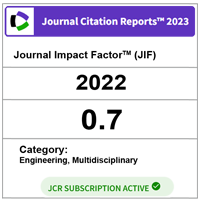DEVELOPMENT OF SLOPE MONITORING DEVICE USING ACCELEROMETER
DOI:
https://doi.org/10.11113/jt.v78.9624Keywords:
Monitoring device, slope deformation, sensor database system, physical modelling, numerical modellingAbstract
There are many types of instruments that have been used for monitoring the high risk slopes as a precaution to prevent the loss of lives. Unfortunately, there is no such works of installation slope monitoring instrumentation as detectors and preventive actions before the slope failure. Automatic Wireless Accelerometer Monitoring System (AWAM) is a new device of monitoring system using accelerometer, introduced in this research. It is more efficient than conventional techniques and less expensive. The application and operation of this system does not interrupted by physical obstacles, different climate conditions, and the construction works at site. In addition, no contact is required since the accelerometers are installed on the slope. Consequently, geomorphology limitations are not considered as limitations of the system operation. This paper discusses the sensor database system by AWAM and shows the effectiveness of the device to monitor slope failures and act as a warning sign. It was presented in two parts; the first part consisted of the physical modelling calibration test from sensor database system (AWAM device) and from load cell test while the second part discussed on the numerical model simulated by using software (Slope/W and LimitState) and the data from vane shear test. The AWAM device can be used as a monitoring system to detect soil movements. However, accelerometer was able to give AWAM’s readings if the device is moving in tilting modes.References
Ahmed, J., Ghazali, M. A., Mukhlisin, M., Alias, M. N. and Taha, M. R. 2011. Effectiveness of Horizontal Drains in Improving Slope Stability: A Case Study Of Landslide Event In Putrajaya Precinct 9, Malaysia. Unsaturated Soils: Theory and Practice: 753-758.
Chowdhury, R., Flentje, P. and Bhattacharya, G. 2009. Geotechnical Slope Analysis. Crc Press.
Jamaludin, S. and Hussien, A.N. 2006. Landslide Hazard and Risk Assessment: The Malaysian Experience. 10th IAEG International Congress, Nottingham, United Kingdom, 6 – 10 September 2006.
Gue, S. S. and Tan, Y. C. 2006. Landslides: Case Histories, Lesson Learned and Mitigation Measure. Conference on Landslide, Sinkhole, Structure Failure: MYTH or SCIENCE?. Ipoh, Perak. 6-7 March 2006.
Angeli, M-G., Alessandro, P., and Sandro, S. 2000. A Critical Review of Landslide Monitoring Experiences. Engineering Geology. 55.3 (2000): 133-147.
Ding, X., Ren, D., Montgomery, B. and Swindells, C. 2000. Automatic Monitoring Of Slope Deformations Using Geotechnical Instruments. Journal of Surveying Engineering. 126 (2):57-68.
Bozzano,F., Mazzanti, P., Prestininzi A., Mugnozza, G.S. 2010. Research and Development Of Advanced Technologies For Landslide Hazard Analysis In Italy. Landslides. 7 (3): 381-385.
Khan, Y. A., Lateha, H., Jerfriza, A. W. M., and Muhiyuddin, B. 2010. Monitoring of Hill-Slope Movement due to Rainfall at Gunung Pass of Cameron Highland District of Peninsular Malaysia. International Journal of Earth Sciences and Engineering. 3: 06-12.
Gili, J. A., Corominas, J. and Rius, J. 2000. Using Global Positioning System Techniques in Landslide Monitoring. Engineering Geology. 55 (3): 167-192.
Malet, J.P., Maquaire, O. and Calais, E. 2002. The Use of Global Positioning System Techniques for the Continuous Monitoring of Landslides: Application to the Super-Sauze Earthflow (Alpes-de-Haute-Provence,France). Geomorphology. 43 (1): 33-54.
Megawati, K., Pan, T.C. and Koketsu, K. 2005. Response Spectral Attenuation Relationships for Sumatran-Subduction Earthquakes and the Seismic Hazard Implications to Singapore and Kuala Lumpur. Soil Dynamics and Earthquake Engineering. 25(1):11-25.
Kalatehjari, R., Arefnia, A., A Rashid, A.S., Ali, N. and Hajihassani, M. 2015. Determination of Three-Dimensional Shape of Failure in Soil Slopes. Canadian Geotechnical Journal, 52 (9):1283-1301.
Downloads
Published
Issue
Section
License
Copyright of articles that appear in Jurnal Teknologi belongs exclusively to Penerbit Universiti Teknologi Malaysia (Penerbit UTM Press). This copyright covers the rights to reproduce the article, including reprints, electronic reproductions, or any other reproductions of similar nature.





